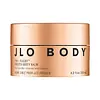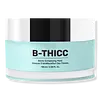What's inside
What's inside
 Key Ingredients
Key Ingredients

 Benefits
Benefits

 Concerns
Concerns

 Ingredients Side-by-side
Ingredients Side-by-side

Water
Skin ConditioningC12-15 Alkyl Benzoate
AntimicrobialCaprylic/Capric Triglyceride
MaskingGlycerin
HumectantKaolin
AbrasiveCetearyl Alcohol
EmollientButylene Glycol
HumectantPropanediol
SolventGlyceryl Stearate
EmollientAlumina
AbrasiveCI 77891
Cosmetic ColorantCaffeine
Skin Conditioning1,2-Hexanediol
Skin ConditioningMagnesium Aluminum Silicate
AbsorbentMenthyl Ethylamido Oxalate
Skin ConditioningOlea Europaea Fruit Oil
MaskingSqualane
EmollientOcimum Sanctum Leaf Extract
Skin ConditioningPersea Gratissima Fruit Extract
EmollientSolanum Melongena Fruit Extract
Skin ConditioningMelia Azadirachta Flower Extract
Skin ConditioningCorallina Officinalis Extract
Skin ConditioningCoccinia Indica Fruit Extract
Skin ConditioningPseudozyma Epicola/Olive Fruit Oil Ferment Filtrate
HumectantSchinus Terebinthifolia Seed Extract
AstringentPaullinia Cupana Seed Extract
Skin ConditioningPtychopetalum Olacoides Bark Extract
Skin ConditioningMelia Azadirachta Leaf Extract
Skin ConditioningSodium Hyaluronate
HumectantCurcuma Longa Root Extract
MaskingAloe Barbadensis Flower Extract
EmollientOcimum Basilicum Flower/Leaf Extract
TonicTocopheryl Acetate
AntioxidantButyrospermum Parkii Butter
Skin ConditioningBetaine
HumectantBentonite
AbsorbentPEG-40 Stearate
EmulsifyingSaccharide Isomerate
HumectantTriheptanoin
Skin ConditioningSodium Acrylate/Sodium Acryloyldimethyl Taurate Copolymer
Emulsion StabilisingCoco-Caprylate/Caprate
EmollientXanthan Gum
EmulsifyingCeteareth-20
CleansingPolyisobutene
Citric Acid
BufferingDimethicone
EmollientPolyurethane-10
Vanillyl Butyl Ether
MaskingEthylhexylglycerin
Skin ConditioningTrisodium Ethylenediamine Disuccinate
Silica
AbrasiveTin Oxide
AbrasiveCaprylyl/Capryl Glucoside
CleansingSodium Hydroxide
BufferingPhenoxyethanol
PreservativeParfum
MaskingBenzyl Salicylate
PerfumingCitronellol
PerfumingGeraniol
PerfumingHexyl Cinnamal
PerfumingHydroxycitronellal
PerfumingLinalool
PerfumingWater, C12-15 Alkyl Benzoate, Caprylic/Capric Triglyceride, Glycerin, Kaolin, Cetearyl Alcohol, Butylene Glycol, Propanediol, Glyceryl Stearate, Alumina, CI 77891, Caffeine, 1,2-Hexanediol, Magnesium Aluminum Silicate, Menthyl Ethylamido Oxalate, Olea Europaea Fruit Oil, Squalane, Ocimum Sanctum Leaf Extract, Persea Gratissima Fruit Extract, Solanum Melongena Fruit Extract, Melia Azadirachta Flower Extract, Corallina Officinalis Extract, Coccinia Indica Fruit Extract, Pseudozyma Epicola/Olive Fruit Oil Ferment Filtrate, Schinus Terebinthifolia Seed Extract, Paullinia Cupana Seed Extract, Ptychopetalum Olacoides Bark Extract, Melia Azadirachta Leaf Extract, Sodium Hyaluronate, Curcuma Longa Root Extract, Aloe Barbadensis Flower Extract, Ocimum Basilicum Flower/Leaf Extract, Tocopheryl Acetate, Butyrospermum Parkii Butter, Betaine, Bentonite, PEG-40 Stearate, Saccharide Isomerate, Triheptanoin, Sodium Acrylate/Sodium Acryloyldimethyl Taurate Copolymer, Coco-Caprylate/Caprate, Xanthan Gum, Ceteareth-20, Polyisobutene, Citric Acid, Dimethicone, Polyurethane-10, Vanillyl Butyl Ether, Ethylhexylglycerin, Trisodium Ethylenediamine Disuccinate, Silica, Tin Oxide, Caprylyl/Capryl Glucoside, Sodium Hydroxide, Phenoxyethanol, Parfum, Benzyl Salicylate, Citronellol, Geraniol, Hexyl Cinnamal, Hydroxycitronellal, Linalool
Water
Skin ConditioningGlycerin
HumectantCetearyl Alcohol
EmollientEthylhexyl Palmitate
EmollientSynthetic Beeswax
Emulsion StabilisingXylitylglucoside
HumectantAnhydroxylitol
HumectantSodium Polyacrylate Starch
AbsorbentGlyceryl Stearate
EmollientGlyceryl Stearate Se
EmulsifyingPEG-100 Stearate
Phenoxyethanol
PreservativeVitis Vinifera Seed Oil
EmollientXylitol
HumectantCaprylyl Glycol
EmollientDimethicone
EmollientHydroxyethyl Acrylate/Sodium Acryloyldimethyl Taurate Copolymer
Emulsion StabilisingParfum
MaskingAlcohol Denat.
AntimicrobialGlucose
HumectantXanthan Gum
EmulsifyingChlorella Vulgaris/Lupinus Albus Protein Ferment
Skin ConditioningGarcinia Mangostana Peel Extract
Skin ConditioningPyrus Cydonia Seed Extract
MaskingLimonene
PerfumingSodium Benzoate
MaskingPanthenol
Skin ConditioningSodium Hyaluronate
HumectantDisodium EDTA
Potassium Sorbate
PreservativeMaltodextrin
AbsorbentLinalool
PerfumingCI 42090
Cosmetic ColorantWater, Glycerin, Cetearyl Alcohol, Ethylhexyl Palmitate, Synthetic Beeswax, Xylitylglucoside, Anhydroxylitol, Sodium Polyacrylate Starch, Glyceryl Stearate, Glyceryl Stearate Se, PEG-100 Stearate, Phenoxyethanol, Vitis Vinifera Seed Oil, Xylitol, Caprylyl Glycol, Dimethicone, Hydroxyethyl Acrylate/Sodium Acryloyldimethyl Taurate Copolymer, Parfum, Alcohol Denat., Glucose, Xanthan Gum, Chlorella Vulgaris/Lupinus Albus Protein Ferment, Garcinia Mangostana Peel Extract, Pyrus Cydonia Seed Extract, Limonene, Sodium Benzoate, Panthenol, Sodium Hyaluronate, Disodium EDTA, Potassium Sorbate, Maltodextrin, Linalool, CI 42090
Ingredients Explained
These ingredients are found in both products.
Ingredients higher up in an ingredient list are typically present in a larger amount.
Cetearyl alcohol is a mixture of two fatty alcohols: cetyl alcohol and stearyl alcohol. It is mainly used as an emulsifier. Emulsifiers help prevent the separation of oils and products. Due to its composition, it can also be used to thicken a product or help create foam.
Cetearyl alcohol is an emollient. Emollients help soothe and hydrate the skin by trapping moisture.
Studies show Cetearyl alcohol is non-toxic and non-irritating. The FDA allows products labeled "alcohol-free" to have fatty alcohols.
This ingredient is usually derived from plant oils such as palm, vegetable, or coconut oils. There is debate on whether this ingredient will cause acne.
Due to the fatty acid base, this ingredient may not be Malassezia folliculitis safe.
Learn more about Cetearyl AlcoholDimethicone is a type of synthetic silicone created from natural materials such as quartz.
What it does:
Dimethicone comes in different viscosities:
Depending on the viscosity, dimethicone has different properties.
Ingredients lists don't always show which type is used, so we recommend reaching out to the brand if you have questions about the viscosity.
This ingredient is unlikely to cause irritation because it does not get absorbed into skin. However, people with silicone allergies should be careful about using this ingredient.
Note: Dimethicone may contribute to pilling. This is because it is not oil or water soluble, so pilling may occur when layered with products. When mixed with heavy oils in a formula, the outcome is also quite greasy.
Learn more about DimethiconeGlycerin is already naturally found in your skin. It helps moisturize and protect your skin.
A study from 2016 found glycerin to be more effective as a humectant than AHAs and hyaluronic acid.
As a humectant, it helps the skin stay hydrated by pulling moisture to your skin. The low molecular weight of glycerin allows it to pull moisture into the deeper layers of your skin.
Hydrated skin improves your skin barrier; Your skin barrier helps protect against irritants and bacteria.
Glycerin has also been found to have antimicrobial and antiviral properties. Due to these properties, glycerin is often used in wound and burn treatments.
In cosmetics, glycerin is usually derived from plants such as soybean or palm. However, it can also be sourced from animals, such as tallow or animal fat.
This ingredient is organic, colorless, odorless, and non-toxic.
Glycerin is the name for this ingredient in American English. British English uses Glycerol/Glycerine.
Learn more about GlycerinGlyceryl Stearate is a mix of glycerin and stearic acid.
It is used to stabilize the mixing of water and oil ingredients. By preventing these ingredients from separating, it can help elongate shelf life. It can also help thicken the product's texture.
As an emollient, it helps soften skin and supports barrier-replenishing ingredients.
In cosmetics, Glyceryl Stearate is often made from vegetable oils or synthetically produced.
This ingredient may not be fungal-acne safe
Fun fact: The human body also creates Glyceryl Stearate naturally.
Learn more about Glyceryl StearateLinalool is a fragrance and helps add scent to products. It's derived from common plants such as cinnamon, mint, citrus, and lavender.
Like Limonene, this ingredient oxidizes when exposed to air. Oxidized linalool can cause allergies and skin sensitivity.
This ingredient has a scent that is floral, spicy tropical, and citrus-like.
Learn more about LinaloolParfum is a catch-all term for an ingredient or more that is used to give a scent to products.
Also called "fragrance", this ingredient can be a blend of hundreds of chemicals or plant oils. This means every product with "fragrance" or "parfum" in the ingredients list is a different mixture.
For instance, Habanolide is a proprietary trade name for a specific aroma chemical. When used as a fragrance ingredient in cosmetics, most aroma chemicals fall under the broad labeling category of “FRAGRANCE” or “PARFUM” according to EU and US regulations.
The term 'parfum' or 'fragrance' is not regulated in many countries. In many cases, it is up to the brand to define this term.
For instance, many brands choose to label themselves as "fragrance-free" because they are not using synthetic fragrances. However, their products may still contain ingredients such as essential oils that are considered a fragrance by INCI standards.
One example is Calendula flower extract. Calendula is an essential oil that still imparts a scent or 'fragrance'.
Depending on the blend, the ingredients in the mixture can cause allergies and sensitivities on the skin. Some ingredients that are known EU allergens include linalool and citronellol.
Parfum can also be used to mask or cover an unpleasant scent.
The bottom line is: not all fragrances/parfum/ingredients are created equally. If you are worried about fragrances, we recommend taking a closer look at an ingredient. And of course, we always recommend speaking with a professional.
Learn more about ParfumPhenoxyethanol is a preservative that has germicide, antimicrobial, and aromatic properties. Studies show that phenoxyethanol can prevent microbial growth. By itself, it has a scent that is similar to that of a rose.
It's often used in formulations along with Caprylyl Glycol to preserve the shelf life of products.
Sodium Hyaluronate is hyaluronic acid's salt form. It is commonly derived from the sodium salt of hyaluronic acid.
Like hyaluronic acid, it is great at holding water and acts as a humectant. This makes it a great skin hydrating ingredient.
Sodium Hyaluronate is naturally occurring in our bodies and is mostly found in eye fluid and joints.
These are some other common types of Hyaluronic Acid:
Learn more about Sodium HyaluronateWater. It's the most common cosmetic ingredient of all. You'll usually see it at the top of ingredient lists, meaning that it makes up the largest part of the product.
So why is it so popular? Water most often acts as a solvent - this means that it helps dissolve other ingredients into the formulation.
You'll also recognize water as that liquid we all need to stay alive. If you see this, drink a glass of water. Stay hydrated!
Learn more about WaterXanthan gum is used as a stabilizer and thickener within cosmetic products. It helps give products a sticky, thick feeling - preventing them from being too runny.
On the technical side of things, xanthan gum is a polysaccharide - a combination consisting of multiple sugar molecules bonded together.
Xanthan gum is a pretty common and great ingredient. It is a natural, non-toxic, non-irritating ingredient that is also commonly used in food products.
Learn more about Xanthan Gum